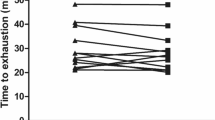Summary
The shivering, body temperature, and metabolic response to stable and decreasing ambient temperature were measured in winter acclimatized Black-capped Chickadees,Parus atricapillus. Shivering activity, measured by duration and amplitude of bursts, increased curvilinearly from thermoneutral temperatures of 27°C down to 0°C. This parabolic shivering response may be a major component of the curvilinear response of metabolism to decreasing ambient temperature.
Birds exposed to 0°C exhibited metabolism 32–45% lower than predicted for a 12-g homeotherm and body temperatures 10°C below the pre-experimental nocturnal body temperature. This hypothermia was not the result of a breakdown in thermoregulation, but was a controlled effort serving to reduce overnight energy expenditure. It is suggested that (1) hypothermia was achieved by decreased shivering by pectoral muscles during exposure to decreasing ambient temperatures, (2) the rate of body temperature decline was moderated by intermittent and reduced bursts during the cooling period, and (3) body temperature was maintained at a particular level during exposure to a stable low ambient temperature by intense bursts lasting one to three minutes.
The physiology of hypothermia in chickadees is similar to torpor; however, chickadees did not arouse to a normal diurnal body temperature in the laboratory, and their hypothermia was not induced by inanition or prolonged exposure to cold, as reported for other species capable of torpor.
Similar content being viewed by others
References
Aschoff, J., Pohl, H.: Rhythmic variations in energy metabolism. Fed. Proc. Fed. Amer. Soc. Exp. Biol.29, 1541–1552 (1970)
Austin, G.T., Bradley, W.B.: Additional responses of the poorwill to low temperatures. Auk86, 717–725 (1969)
Bartholomew, G.A., Howell, T., Cade, T.J.: Torpidity in the white-throated swift, anna humming-bird, and poorwill. Condor59, 145–155 (1957)
Bartholomew, G.A., Hudson, J.W., Howell, T.: Body temperature, oxygen consumption, evaporative heat loss, and heart rate in the poorwill. Condor64, 117–125 (1962)
Brooks, W.S.: Comparative adaptations of the Alaskan redpolls to the arctic environment. Wilson Bull.80, 253–280 (1968)
Calder, W.A., King, J.R.: Thermal and caloric relations of birds. In: Avian biology, Vol. IV (Farner, D.S., King, J.R., eds.) New York: Academic Press 1974
Carpenter, F.L.: Torpor in an Andean hummingbird: its ecological significance. Science183, 545–547 (1974)
Chaplin, S.B.: Daily energetics of the black-capped chickadee,Parus atricapillus, in winter. J. comp. Physiol.89, 321–330 (1974)
Cheke, R.A.: Temperature rhythms in African montane sunbirds.Ibis113, 500–506 (1971)
Dawson, W.R., Fisher, C.D.: Responses to temperature by the spotted nightjar (Eurostopodus guttatus). Condor71, 49–53 (1969)
Dawson, W.R., Hudson, J.W.: Birds. In: Comparative physiology of thermoregulation, Vol. I (Whittow, G.C., ed.). New York: Academic Press 1970
Haftorn, S.: Hypothermia of tits in the arctic winter. Ornis Scand.3, 153–166 (1972)
Hart, J.S.: Seasonal acclimatization in four species of small wild birds. Physiol. Zool.35, 224–236 (1962)
Hensel, H.: Neural processes in thermoregulation. Physiol. Rev.53, 948–1017 (1973)
Lasiewski, R.C., Dawson, W.R.: Physiological responses to temperature in the common nighthawk. Condor66, 477–490 (1964)
Lasiewski, R.C., Weathers, W.W., Bernstein, M.H.: Physiological responses of the giant hummingbird,Patagona gigas. Comp. Biochem. Physiol.23, 797–813 (1967)
MacMillen, R.E., Trost, C.H.: Nocturnal hypothermia in the inca dove,Scardafella inca. Comp. Biochem. Physiol.23, 243–253 (1967)
Mugaas, J.N., Templeton, J.R.: Thermoregulation in the red-breasted nuthatch (Sitta canadensis). Condor72, 125–132 (1970)
Snedecor, G.W. Cochran, W.G.: Statistical methods. 6th ed. 593 pp. Ames: Iowa State Press 1967
Steen, J., Enger, P.S.: Muscular heat production in pigeons during exposure to cold. Amer. J. Physiol.19, 157–158 (1957)
Steen, J.: Climatic adaptation in some small northern birds. Ecology39, 625–629 (1958)
West, G.C.: Shivering heat production in wild birds. Physiol. Zool.38, 111–119 (1965)
Wolf, L.L., Hainsworth, F.R.: Environmental influence on regulated body temperature in torpid hummingbirds. Comp. Biochem. Physiol.41, 167–174 (1972)
Author information
Authors and Affiliations
Rights and permissions
About this article
Cite this article
Chaplin, S.B. The physiology of hypothermia in the black-capped Chickadee,Parus atricapillus . J Comp Physiol B 112, 335–344 (1976). https://doi.org/10.1007/BF00692303
Received:
Issue Date:
DOI: https://doi.org/10.1007/BF00692303




